
RESEARCH Open Access
Innegligible musculoskeletal disorders caused by
zoledronic acid in adjuvant breast cancer
treatment: a meta-analysis
Wen-Bin Zhou
1
, Peng-Ling Zhang
2
, Xiao-An Liu
1
, Tao Yang
3
and Wei He
3*
Abstract
Background: Zoledronic acid (ZOL) is widely used for preventing bone loss in early breast cancer patients.
However, the adverse effects caused by ZOL itself should not be neglected. Musculoskeletal disorders were
common after ZOL administration and distressing to the patients. Up to now, no precise estimation of
musculoskeletal disorders has been made.
Methods: Relevant randomized clinical trials were selected by searching the electronic database PubMed, and a
meta-analysis was conducted.
Results: Four trials reported musculoskeletal disorders of ZOL treatment versus no ZOL, including 2684 patients
treated with ZOL and 2712 patients without ZOL treatment. Compared to patients without ZOL treatment, patients
treated with ZOL had a significantly higher risk of arthralgia (risk ratio (RR): 1.162, 95% confidence interval (CI):
1.096-1.232, P= 0.466 for heterogeneity) and bone pain (RR: 1.257, 95% CI: 1.149-1.376, P= 0.193 for
heterogeneity). Three clinical trials reported the complications of upfront versus delayed ZOL treatment, including
1091 patients with upfront ZOL and 1110 patients with delayed ZOL. The rate of bone pain in upfront group (119/
824) was significantly higher than that in delayed group (74/836) (RR: 1.284, 95% CI: 1.135-1.453, P= 0.460 for
heterogeneity).
Conclusions: Our meta-analysis suggested that treatment with ZOL was significantly associated to the occurrence
of arthralgia and bone pain. Moreover, higher rate of bone pain was observed in patients treated with upfront ZOL
compared with delayed ZOL treatment. More attentions should be paid to patients treated with ZOL, especially for
immediate ZOL. For patients with low risk of osteoporosis, immediate ZOL may be not needed due to additional
musculoskeletal disorders and little benefit. Or it can be stopped after the occurrence of these adverse events.
Keywords: zoledronic acid, musculoskeletal disorders, breast cancer, meta-analysis
Introduction
More patients with early breast cancer have been diag-
nosed with the development of screening techniques [1].
Following adjuvant chemotherapy and endocrine therapy
can significantly improve disease-free survival (DFS) and
overall survival (OS) in early breast cancer patients
[2-4]. However, both adjuvant chemotherapy and endo-
crine therapy cause bone loss to these patients. Patients
with amenorrhea after chemotherapy [5,6] and postme-
nopausal patients receiving aromatase inhibitors (AIs)
are at high risk of bone loss [3,4,7-9].
Zoledronic acid (ZOL) can prevent bone loss in early
breast cancer patients [10]. Furthermore, ZOL also has
antitumor and antimetastatic properties. The previous
meta-analysis [11] suggested that the use of ZOL was
associated with a statistically significant lower risk for
disease recurrence. In addition, ZOL has several poten-
tial advantages compared to the oral bisphosphonates,
including good bioavailability, gastrointestinal tolerance,
and adequate compliance [12]. Thus, less adverse effects,
such as gastrointestinal disorders and vascular disorders,
* Correspondence: hewei1007@sina.cn
3
Department of Endocrinology and Metabolism, The First Affiliated Hospital
with Nanjing Medical University, 300 Guangzhou Road, 210029 Nanjing,
China
Full list of author information is available at the end of the article
Zhou et al.Journal of Experimental & Clinical Cancer Research 2011, 30:72
http://www.jeccr.com/content/30/1/72
© 2011 Zhou et al; licensee BioMed Central Ltd. This is an Open Access article distributed under the terms of the Creative Commons
Attribution License (http://creativecommons.org/licenses/by/2.0), which permits unrestricted use, distribution, and reproduction in
any medium, provided the original work is properly cited.

were caused by ZOL [12]. However, the adverse effects
caused by ZOL itself should not be neglected. Osteone-
crosis of the jaw, an uncommon serious side effect
caused by ZOL, has been paid close attention. Previous
study [13] showed that osteonecrosis of the jaw
occurred in only about 0.33% of patients treated with
ZOL. Musculoskeletal disorders were common after
ZOL administration and distressing to the patients. Up
to now, no precise estimation of musculoskeletal disor-
ders has been made. Previous randomized clinical trials
[14-17] showed that musculoskeletal disorders occurred
in more than 20% patients treated with ZOL and in
more than 10% patients without ZOL treatment.
Furthermore, some randomized trials [12,18,19] were
conducted to evaluate the efficacy of upfront ZOL ver-
sus delayed ZOL in preventing bone loss. The muscu-
loskeletal disorders reported by these trials were
discordant.
The UK Expert Group [20] suggested that bispho-
sphonates should be administrated to patients with high
risk of osteoporosis. However, patients with low risk of
osteoporosis might benefit little from ZOL treatment.
When ZOL was considered to be administrated to
patients, the benefit and adverse effects should be well
balanced. We performed this meta-analysis to give a
precise estimation of the musculoskeletal disorders of
ZOL versus no ZOL and upfront ZOL versus delayed
ZOL in adjuvant breast cancer treatment.
Methods
Search strategy
The present study was conducted as described previously
[21-23]. Relevant studies were selected by searching the
electronic database PubMed (updated on May 1, 2011),
using the following terms: early or adjuvant, breast can-
cer or breast neoplasm, zoledronic acid or bisphospho-
nates. Two investigators (Zhou WB and Liu XA)
independently evaluated titles and abstracts of the identi-
fied papers. References in identified articles and reviews
were also reviewed for possible inclusion. Only published
randomized clinical trials in English language were
included in our study. Randomized clinical trials were
included if they met the following criteria: (1) ZOL used
in breast cancer patients in adjuvant setting; (2) ZOL
used with a control group receiving no treatment or pla-
cebo, or upfront ZOL (receiving ZOL immediately after
randomization) versus delayed ZOL (receiving ZOL only
if T-score fell below -2.0, after a nontraumatic clinical
fracture, or if an asymptomatic fracture); (3) enough pub-
lished data for estimated a risk ratio (RR) with 95% confi-
dence interval (CI). In addition, to avoid duplication of
information, only the report with longest follow-up was
included for calculations when multiple reports pertained
to overlapping groups of patients.
Data extraction
The data of musculoskeletal disorders, including arthral-
gia, bone pain and muscle pain, were carefully extracted
from all the eligible randomized trials independently by
two investigators (Zhou WB and Liu XA). The following
variables were extracted from each study: first author’s
name, the name of each trial, publication year, the med-
ian follow-up time, the number of total patients in every
group, and the number of patients with musculoskeletal
disorders in every group. All the data were reached con-
sensus after discussion.
Statistical analysis
Crude RRs with 95% CI were used to assess the muscu-
loskeletal disorders risk of ZOL. The between-study het-
erogeneity was tested with Q statistics (significant
differences indicated by P< 0.10) [24]. The fixed-effects
model (the Mantel-Haenszel method) was used when
between-study was absent [25]. Otherwise, the random-
effects model (the DerSimonian and Laird method) was
selected [26]. Funnel plots and Egger’s linear regression
were used to test the publication bias and a Pvalue less
than 0.05 was considered significant. All analyses were
performed using the software Stata version 11.0 (Stata
Corporation, College Station, TX, USA).
Results
Eligible studies
Ten randomized clinical trials, in which ZOL was used
in adjuvant setting, were identified. Of these ten studies,
the detail data of musculoskeletal disorders were not
reported in three studies [27-29]. In all, seven studies
[12,14-19] were eligible in this meta-analysis. Table 1
presented the characteristics of the seven trials. Of these
seven studies, four studies [14-17] reported musculoske-
letal disorders of ZOL versus placebo or no treatment,
including 2684 patients treated with ZOL and 2712
patients treated with placebo or no treatment. Three
studies [12,18,19] reported the complications of upfront
versus delayed ZOL, including 1091 patients with
upfront ZOL and 1110 patients with delayed ZOL.
ZOL versus no ZOL
Table 2 showed the main results of this meta-analysis.
Arthralgia occurred in about 23.9%-68% patients treated
with ZOL and 12.5%-60.4% patients without ZOL treat-
ment. Compared to patients without ZOL treatment,
patients treated with ZOL had a significantly higher risk
of arthralgia (RR: 1.162, 95% CI: 1.096-1.232, P= 0.466
for heterogeneity) (Figure 1). Bone pain occurred in
about 35.3%-40% patients treated with ZOL and in
24.6%-41.5% patients without ZOL treatment. Similarly,
a significantly higher risk of bone pain was observed in
patients with ZOL treatment (RR: 1.257, 95% CI: 1.149-
Zhou et al.Journal of Experimental & Clinical Cancer Research 2011, 30:72
http://www.jeccr.com/content/30/1/72
Page 2 of 7

1.376, P= 0.193 for heterogeneity) (Figure 2). However,
there was no significantly different risk of muscle pain
between the two groups (RR: 1.198, 95% CI: 0.901-1.594,
P= 0.366 for heterogeneity).
Funnel plot and Egger’s test were performed to access
the publication bias of the four studies. No significant
publication bias (P> 0.05) existed (data not shown).
Upfront versus delayed-start ZOL
The main results were also showed in Table 2. Arthral-
gia occurred in 12.7%-42.2% patients treated with
upfront ZOL and in 11.3%-40.7% patients with delayed
ZOL. There was no significantly different risk of arthral-
gia between the two groups (RR: 1.022, 95% CI: 0.932-
1.120, P= 0.850 for heterogeneity). The similar results
were observed about muscle pain between the two
groups (RR: 1.071, 95% CI: 0.942-1.217, P= 0.422 for
heterogeneity). The rates of muscle pain were 6.4%-
16.3% and 5.1%-12.1% in upfront group and delayed
group, respectively. Bone pain caused by ZOL was
reported in Z-FAST and ZO-FAST trials. The rate of
bone pain in upfront group (119/824) was significantly
higher than that in delayed group (74/836) (RR: 1.284,
95% CI: 1.135-1.453, P= 0.460 for heterogeneity) (Fig-
ure 3).
Since only three trials were included in this analysis of
musculoskeletal disorders between upfront and delayed
ZOL groups, publication bias was not accessed.
Discussion
Previous randomized clinical trials showed that muscu-
loskeletal disorders occurred in a high rate of patients
treated with ZOL. This meta-analysis suggested that
patients treated with ZOL had a statistically significant
higher risk of arthralgia and bone pain compared to
patients without ZOL treatment. Furthermore, patients
treated with upfront ZOL had a significant higher risk
of bone pain than patients with delayed ZOL.
Although ZOL can bypass the potential disadvantages
of the oral route used by other bisphosphonates, it may
cause more musculoskeletal disorders than other
bisphosphonates [30-32]. A high rate of musculoskeletal
disorders occurred in patients treated with ZOL.
Patients treated with ZOL had a statistically significant
Table 1 Characteristics of eligible trials
Author
(Study)
Year Intervention Dosage of treatment Duration
(yr)
Number of
patients
Follow-up
(mo)
Gnant
(ABCSG12)
2009 Zoledronic acid
No treatment
4 mg IV every 6 months 3 899
904
47.8
Shapiro
(CALGB)
2011 Zoledronic acid
No treatment
4 mg IV every 3 months NA 70
80
12
Hershman 2008 Zoledronic acid
Placebo
4 mg IV every 3 months 1 50
53
12
Coleman
(AZURE)
2011 Zoledronic acid
No treatment
4 mg IV monthly for 6 months, then every 3 months for 8 doses
and then every 6 months for 5 doses
5 1665
1675
6
Brufsky (Z-
FAST)
2009 Upfront
zoledronic acid
Delayed
zoledronci acid
4 mg IV every 6 months 5 300
300
36
Eidtmann
(ZO-FAST)
2010 Upfront
zoledronic acid
Delayed
zoledronci acid
4 mg IV every 6 months 5 524
536
36
Hines
(N03CC)
2009 Upfront
zoledronic acid
Delayed
zoledronci acid
4 mg IV every 6 months 5 267
274
12
yr, year; mo, months; IV, intravenous; NA, not available
Table 2 Summary RRs and 95% CI
Complications ZOL vs no ZOL Upfront ZOL vs delayed ZOL
RR (95%CI) P
⋆
Number of studies RR (95%CI) P
⋆
Number of studies
Arthralgia 1.162 (1.096-1.232)
#
0.466 4 1.022 (0.932-1.120) 0.850 3
Bone pain 1.257 (1.149-1.376) 0.193 2 1.284 (1.135-1.453) 0.460 2
Muscle pain 1.198 (0.901-1.594) 0.366 2 1.071 (0.942-1.217) 0.422 3
RR, risk ratio; CI, confidence interval; ZOL, zoledronic acid;
*Pvalue for between-study heterogeneity; #the number in AZURE trial included the number of arthralgia and muscle pain.
Zhou et al.Journal of Experimental & Clinical Cancer Research 2011, 30:72
http://www.jeccr.com/content/30/1/72
Page 3 of 7

Figure 1 Forest plot for meta-analysis of arthralgia of patients treated with zoledronic acid (ZOL) versus no ZOL.
Figure 2 Forest plot for meta-analysis of bone pain of patients treated with zoledronic acid (ZOL) versus no ZOL.
Zhou et al.Journal of Experimental & Clinical Cancer Research 2011, 30:72
http://www.jeccr.com/content/30/1/72
Page 4 of 7

higher risk of arthralgia and bone pain than patients
without ZOL treatment. These adverse effects bring
anxiety to patients and may threaten patients’life quality
in some conditions. These adverse effects generally
resolve within 48 hours and respond well to nonsteroi-
dal anti-inflammatory drugs [33]. Of these patients,
some suffered serious musculoskeletal disorders from
ZOL treatment, which exist longer and respond worse
to anti-inflammatory drugs. Sometimes, serious muscu-
loskeletal disorders cause treatment withdrawal.
Although most musculoskeletal disorders will disappear
spontaneously, we should take more attentions to
patients treated with ZOL. The dose, frequency, and
speed of infusion are all important determinants of
these adverse effects [33]. When patients with high risk
of osteoporosis suffered serious musculoskeletal disor-
ders from ZOL, the risk-reducing measures should be
considered. These measures included reducing the dose,
slowing the infusion rate and prolonging the interval
between infusions. When the patients can not tolerate
these adverse effects, other oral bisphosphonates should
be considered [33]. When ZOL was administrated to
patients with low risk of osteoporosis, little benefit but
additional musculoskeletal disorders would be brought
to these patients.
Three randomized clinical trials [12,18,19] were con-
ducted to compare upfront ZOL with delayed ZOL for
prevention of bone loss in postmenopausal women.
These studies suggested that upfront ZOL was more
effective in preserving bone mineral density than
delayed ZOL, but no significant difference in fracture
rate was observed. The UK Expert Group [20] sug-
gested that patients with low risk of osteoporosis did
not need a special treatment, while patients with high
risk should be treated with bisphosphonates. Our
results suggested more musculoskeletal disorders were
observed in patients treated with upfront ZOL. Since
not all patients need upfront ZOL treatment, delayed
ZOL may be considered preferentially in some condi-
tions. In addition, although ZO-FAST trial showed
that upfront ZOL led to improved DFS, further rando-
mized trials are required to investigate the survival
and adverse effects between upfront ZOL and delayed
ZOL.
Several limitations of this meta-analysis should be
considered when interpreting these results. First, of
these seven studies, most subjects were Caucasians,
while seldom Asians were included. Second, the present
results were based on unadjusted RRs. More precise
estimation may be adjusted by other potential covariates.
Third, due to lack of data on musculoskeletal disorders,
three trials were excluded. Since these studies were with
small sample size, they were unlikely to change signifi-
cantly our results.
Figure 3 Forest plot for meta-analysis of bone pain of patients treated with upfront zoledronic acid (ZOL) versus delayed ZOL.
Zhou et al.Journal of Experimental & Clinical Cancer Research 2011, 30:72
http://www.jeccr.com/content/30/1/72
Page 5 of 7


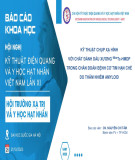

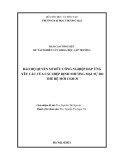
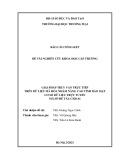
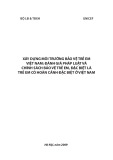
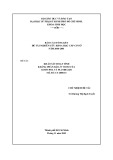
![Vaccine và ứng dụng: Bài tiểu luận [chuẩn SEO]](https://cdn.tailieu.vn/images/document/thumbnail/2016/20160519/3008140018/135x160/652005293.jpg)

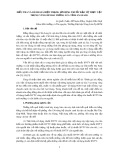





![Báo cáo seminar chuyên ngành Công nghệ hóa học và thực phẩm [Mới nhất]](https://cdn.tailieu.vn/images/document/thumbnail/2025/20250711/hienkelvinzoi@gmail.com/135x160/47051752458701.jpg)









